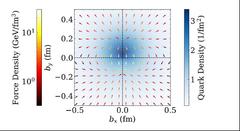A look at the simulations that calculated the forces on the quarks.
An international team of theoretical physicists led by DESY emeritus scientist Gerrit Schierholz has calculated the force felt by individual quarks inside of the building block of the atomic nucleus. The value and direction of this force can now be interpreted on each quark, which could have an impact on how experiments at future particle colliders will be conducted and interpreted. The result has been selected as a research highlight in the prestigious scientific journal Physical Review Letters.
DESY has long been one of the primary locations to find out about the structure inside of protons. After all, the four detectors of the HERA collider (1992-2007) revealed the amazing internal environment of the positively charged building block of the atomic nucleus. And before that, in 1979, the boson that represents the force that binds the atomic nucleus and its components together, the gluon, was discovered at DESY.
Building on that knowledge base in Hamburg, Schierholz assembled former colleagues from across the globe to model the strength and, in an advancement, the direction of the strong force on the individual quarks. “In my time at DESY, I brought many people to Hamburg, and since then, they scattered all around the world: China, Great Britain, Australia, the USA. I brought them back together to conduct this analysis.” Using the supercomputing capabilities at Germany, particularly in Berlin and Göttingen the Northern German supercomputing network HLRN, and a technique called Lattice Quantum Chromodynamics, the team created models of individual quarks within protons as per the models created at HERA and measured what the resulting forces on each individual quark would look like. The method maps the forces over a grid of set points in space-time, while using each point as a reference for the direction and magnitude of the forces, as well as other factors such as distance to the other neighbouring quarks.
“The forces that confine the quarks to the protons are enormous, and they do not lessen with distance,” says Schierholz. “They are each up to 3 billion electronvolts per femtometre, or about a half a million Newtons: roughly equivalent to the weight of ten elephants” – all within the tiny space of the proton. Additionally, the team could see how the direction of the forces aligned with the other quarks in the proton while also seeing how the proton’s spin, a quantum characteristic of the particle, affects the forces on the quark as well.
The results help bring some of the data from HERA into a new light. HERA’s collisions of electrons and protons had resulted in some changes in the spins of the scattered electrons that can be now explained by the spin effects on the forces on the quarks. Similarly, the new results help scientists around the world plan new experiments for future colliders that can probe deeper explorations of quarks and the strong force.
Reference
JA Crawford et al, "Transverse Force Distributions in the Proton from Lattice QCD", Physical Review Letters, 2025, DOI:10.1103/PhysRevLett.134.071901








